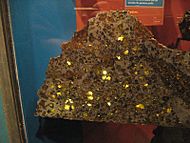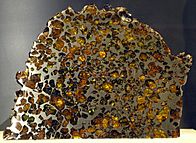Esquel (meteorite) facts for kids
Quick facts for kids Esquel |
|
|---|---|

The slice shows the crystals' transparency
|
|
| Type | Stony–iron |
| Class | Pallasite |
| Group | Main Group Pallasite (MGP) |
| Composition | 8.5% Ni, 21.5 ppm Ga, 55.5 ppm Ge, 0.023 ppm Ir |
| Country | Argentina |
| Region | Esquel, Chubut |
| Coordinates | 42°54′S 71°20′W / 42.900°S 71.333°W |
| Observed fall | No |
| Found date | 1951 |
| TKW | 755 kg |
| [[Commons:Category:Lua error in Module:Wikidata at line 70: attempt to index field 'wikibase' (a nil value). |Related media on Wikimedia Commons]] | |
The Esquel meteorite is a special space rock. It was found near the town of Esquel in Chubut, Argentina. It is a type of meteorite called a pallasite. Pallasites are a kind of stony–iron meteorite. When you cut and polish them, you can see beautiful yellowish crystals inside. These crystals are made of a mineral called olivine, also known as peridot.
A farmer discovered the Esquel meteorite in 1951. He found it while digging a hole for a water tank. In 1992, a meteorite expert named Robert Haag bought it. He then took it to the United States. The Esquel pallasite is famous around the world. Both collectors and scientists admire it. Many people think Esquel is one of the most beautiful meteorites ever found. It is also one of the most wanted pallasites for collectors. It belongs to a group called "main group pallasites" (MGP).
How Big Is the Esquel Meteorite?
Scientists have different ideas about how much the main part of the Esquel meteorite weighs.
- The Meteoritical Bulletin no. 29 (from 1964) said it weighed about 1500 kilograms (3,300 pounds).
- However, O. A. Turone thought the main part weighed 755 kilograms (1,664 pounds).
- Robert Haag, who bought the main part, reported a weight of 680 kilograms (1,500 pounds).
Most of the Esquel meteorite pieces you see today were cut from the part Robert Haag bought.
See also
- Glossary of meteoritics
- In Spanish: Esquel (meteorito) for kids




